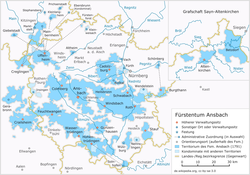Principality of Ansbach
This article includes a list of references, related reading, or external links, but its sources remain unclear because it lacks inline citations. (November 2009) |
Margraviate of Brandenburg-Ansbach / Principality of Ansbach Markgrafschaft Brandenburg-Ansbach / Fürstentum Ansbach | |||||||||
|---|---|---|---|---|---|---|---|---|---|
| 1398–1792 | |||||||||
 The principality of Brandenburg-Ansbach as at 1791, with modern borders | |||||||||
| Status | State of the Holy Roman Empire | ||||||||
| Capital | Ansbach | ||||||||
| Government | Principality | ||||||||
| Historical era | Early modern period | ||||||||
1219 | |||||||||
21 January 1398 | |||||||||
1415–40 | |||||||||
11 June 1420 | |||||||||
• Repartition | 21 September 1440 | ||||||||
• Restoration of personal union | 1470–86 | ||||||||
2 December 1791 | |||||||||
• Formal annexation | 28 January 1792 | ||||||||
| |||||||||
| Today part of | |||||||||
The Principality of Ansbach (German: Fürstentum Ansbach) or Markgraftum Brandenburg-Ansbach was a reichsfrei principality in the Holy Roman Empire centered on the Bavarian city of Ansbach. The ruling Hohenzollern princes of the land were known as margraves, as the principality was a margraviate (but not a march).
History
The principality was established at the death of Frederick V, Burgrave of Nuremberg, on 21 January 1398, when his lands were partitioned between his two sons. The younger son, Frederick VI, received Ansbach and the elder, John III, received Bayreuth. After John III's death on 11 June 1420, the two principalities were reunited under Frederick VI, who had become Elector Frederick I of Brandenburg in 1415.
Upon Frederick I's death on 21 September 1440, his territories were divided between his sons; John received the principality of Bayreuth (Brandenburg-Kulmbach), Frederick received Brandenburg, and Albert received Ansbach. Thereafter Ansbach was held by cadet branches of the House of Hohenzollern, and its rulers were commonly called Margraves of Brandenburg-Ansbach.
On 2 December 1791, the reigning Prince and Margrave of Ansbach, Charles Alexander, who had also succeeded to Bayreuth, sold the sovereignty of his principalities to King Frederick William II of Prussia. The Margrave was middle-aged and childless, and Frederick William was his kinsman as the head of the House of Hohenzollern. The Margrave moved to England with his English second wife. Ansbach was formally annexed on 28 January 1792.
Princes and Margraves of Ansbach
- 1398: Frederick VI, Burgrave of Nuremberg (from 1415 also Elector of Brandenburg)
- 1440: Albert Achilles (from 1470 also Elector of Brandenburg)
- 1486: Frederick I
- 1515: George the Pious
- 1543: George Frederick I
- 1603: Joachim Ernst
- 1625: Frederick II
- 1634: Albert II
- 1667: John Frederick
- 1686: Christian Albrecht
- 1692: George Frederick II the Younger
- 1703: William Frederick (before 1686–1723)
- 1723: Charles William Frederick (1712–1757)
- 1757: Charles Alexander (to 1791)
See also
External links
- German States to 1918, A–E on WorldStatesmen.org
- Marek, Miroslav. "House of Hohenzollern (1 of 2)". Genealogy.EU.
{{cite web}}: External link in|publisher= - Marek, Miroslav. "House of Hohenzollern (2 of 2)". Genealogy.EU.
{{cite web}}: External link in|publisher= - Ansbach and Bayreuth on Tacitus Historical Atlas



